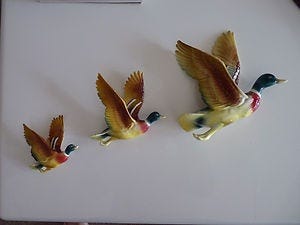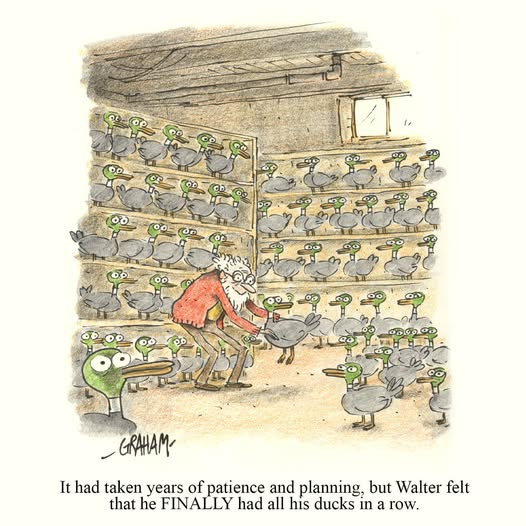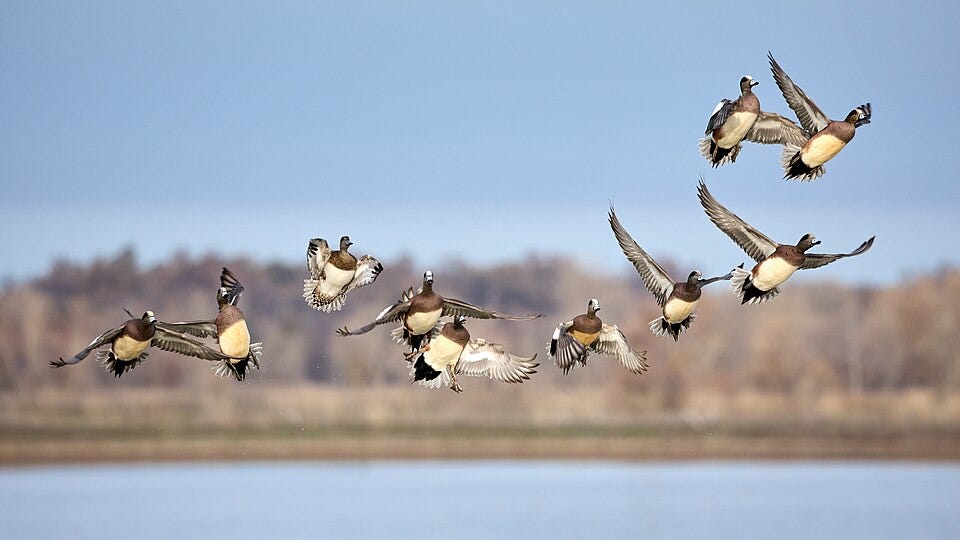alignment ④ if it quacks like a duck in a row
a row is a bit more than a line between points ⓐ and ⓑ
Alignment ① through ③ cover etymologies, my definitions in a worlding context, and the critical fact that a point-of-view (POV), often overlooked by its bearers in worlding their way about, is what aligns and thus a revelation (of the POV) can illustrate the motor, or animation, of what might be considered 'order' or 'structure', in discovery or in construction (when it is just an outcome and not then originary).
This section considers our placing of “ducks in a row”, a phrase with obscured origins. It is intended by this phrase, perhaps in praise or self-satisfaction, that we have attended to all the details of an effort, i.e. that our preparation is complete. Perhaps other animals might be more appropriate to this metaphor, but the row that contains them is key.
Firstly, a row is a little bit more than what a line is, a tad more than the shortest distance between points A & B.
Generally with the phrase “put one’s ducks in a row” I have always imagined mid-20th century ornaments on a suburban lounge room wall: of three ducks, usually mallards, often ceramic, increasing in size, in a row, and in flight, as if migrating.
A row is more illustrative of a vector, a direction, a purpose, a routine.
A line, however, where it is only composed of A & B in connection, is as interesting as dust. But once we have a row, stories abound.
And stories have their reasons. I wonder why?
In the context of worlding the self among others, asking 'why' you would do something is more interesting than 'how' you do that thing. This is because our processes are often not always amenable to conscientious effort of inquiry, and sometimes they are unconscious, or subconscious, so one's hows don’t lead anywhere, even if one hunts in their detail revelation.
Intentions, or reasons held in mind, are area big part of the story. A row can show that more than a line connecting two points.
Where preparation indicates an onward momentum, for some reason.
Movement, motors, animation.
Now asking why and refusing to ask why, require greater efforts than simply looking at how we align ourselves with our worldly engagements (among others or not even).
Keep your head down and don’t look up.Being able to ask why is evidence itself that things vary. Stories ruin order. 'Why' indicates variety, if not diversity. Stories why a population with possibilities, error and survival.
Planing substitutes error for chance.One style of alignment thinks asking 'why' stops you or indeed anyone from ever getting 'your ducks in a row'. For some reason they are locked into one process of preparation. The bearers of this 'style' think that lock-in is a good thing, they align aligning with aligning the one thing. And so they align any 'why' with revolution, or at least disruption, when it may be no such thing at all. Aligning becomes the only reason allowed.
Of course, those who think asking why does threaten the world (they align, they world), and who by forbidding the asking of 'why', in a sense then 'create' a world (world a world) in which asking 'why' does indeed disrupt it. But without this commitment or effort, asking why perhaps would not then disrupt the keeping of one’s ducks in a row.
Afterall a reason why is integral to a movement having a direction. A purpose if not a reasoning. The world is composed of all these movements, being a multitude movements will vary, regardless of your own routines and preferences, habits and entertainments.
One can substitute in here "Order" or "structure" or "the gods” for "ducks in a row". Those who align down hard on forbidding asking why align all these substitutions as equivalent to each other, … and they are right to do so, they think (they align) because otherwise they would be wrong.
Those those who ask why are not nihilists. Asking why is the least nihilistic thing one can ever do.
But some types of alignment/worlding cannot admit that into their efforts, their labours, their movements. Cries of 'nihilism' in labelling those who ask why, are aligned with protective efforts, or beauty, or order, but which they often betray.
Their vector is a line of flight away from what they themselves do in the name of order or getting their ducks in a row.
Ducks themselves may or may not be amenable unless cast in clay.
The take-away here is that a row is much more than a line, which merely hints at what might be possible. Also remember that what makes a line a row is a point-of-view.
Crossposted at whyweshould.loofs-samorzewski.com




